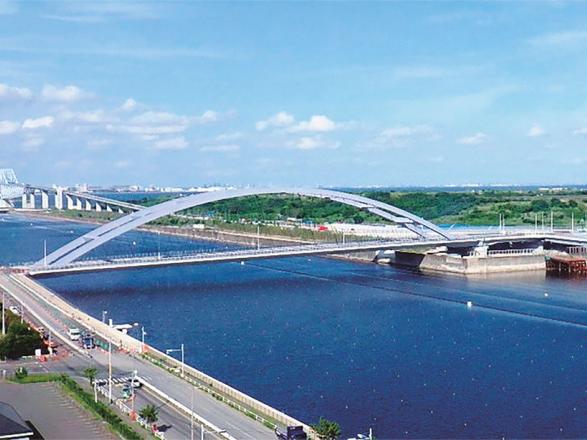Umi no mori Ohashi Bridge, Tokyo – Bridge Monitoring
Challenge
The 2020 Olympic games took place in Tokyo in July 2021 and were watched by more than 3 billion people worldwide. Sporting fans around the globe could take part in the excitement of the event in a way never experienced before, in part due to digital streaming and social media, as well as new broadcast technologies such as Ultra High Definition, High Dynamic Range and immersive audio.
Camera positioning was strategically planned out to ensure the best footage was captured to provide fans with an immersive and realistic viewing experience.
One key location for cameras to capture the sporting action was on the arch ribs of the Umi no Mori Ohashi Bridge (over the Sea Forest Waterway) – completed in 2019, it was a prime location to film activities on the water below, including canoeing and rowing.
Organisers needed to ensure that mounting cameras and equipment with a 23-ton load on the arch ribs of the newly built 250 m bridge would not affect its structural integrity and called on infrastructure consulting company Pacific Consultants Co. Ltd to advise.
Solution
Pacific Consultants Co Ltd recommended a wireless condition monitoring system for the bridge and approached Great Star Japan, Senceive’s distributor, for a wireless and remote condition monitoring solution. GreatStar recommended Senceive’s Optical Displacement (ODS) Sensor Nodes which combine a tilt sensor and laser extensometer in order to measure both rotational and lateral movements. With no wires and a variety of brackets to suit any surface, the compact sensors were the ideal choice.
The FlatMesh™ ODS Nodes were installed on the main girders on both the East and West sides of the bridge to measure arch convergence and divergence. The wireless system included a FlatMesh™ 4G Gateway powered by a solar panel, enabling secure communication with sensor nodes and transmission of measurement data back to Senceive’s cloud-based data management system WebMonitor™.
Outcome
The ODS Nodes proved to be easy to install and reliable. The compact design made them the perfect technology for this application. Alert thresholds were set so stakeholders would get SMS and email notifications in the event of any excessive movement. The sensors remained in place for four and a half months, providing near real-time insight relating to the structural stability of the bridge and helping to ensure the safety of the public throughout the period of additional loading.
The results were accessible on WebMonitor™ and showed a small change in displacement during the measurement period, which was presumed to be correlated to expansion and contraction caused by temperature changes in the bridge. Following removal of the cameras the displacement returned to the original values. The change of 2 mm was approximately 2% of the primary control value (design displacement of 112 mm). Compared to the distance between the girder and arch ribs, this was less than 0.001%, which was considered within safe limits.
Downloads
Created on: Tue 15th Nov 2022


The Optical Displacement Sensors were the ideal choice for this application – they were easy to install and provided the client with insight on the structural stability of the bridge during the period of additional loading.










